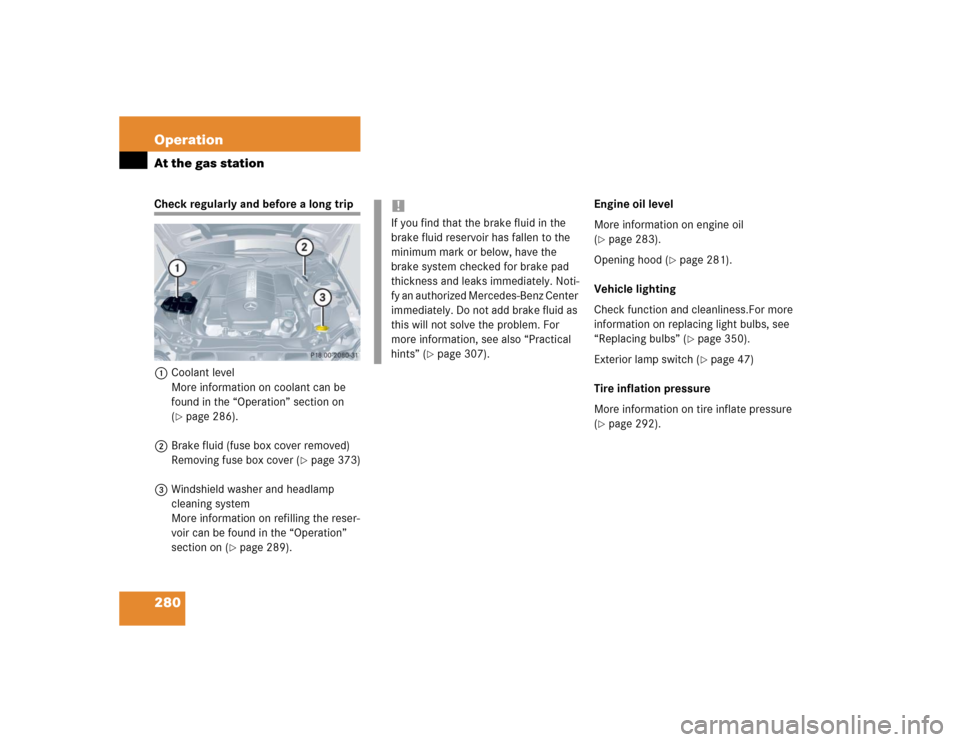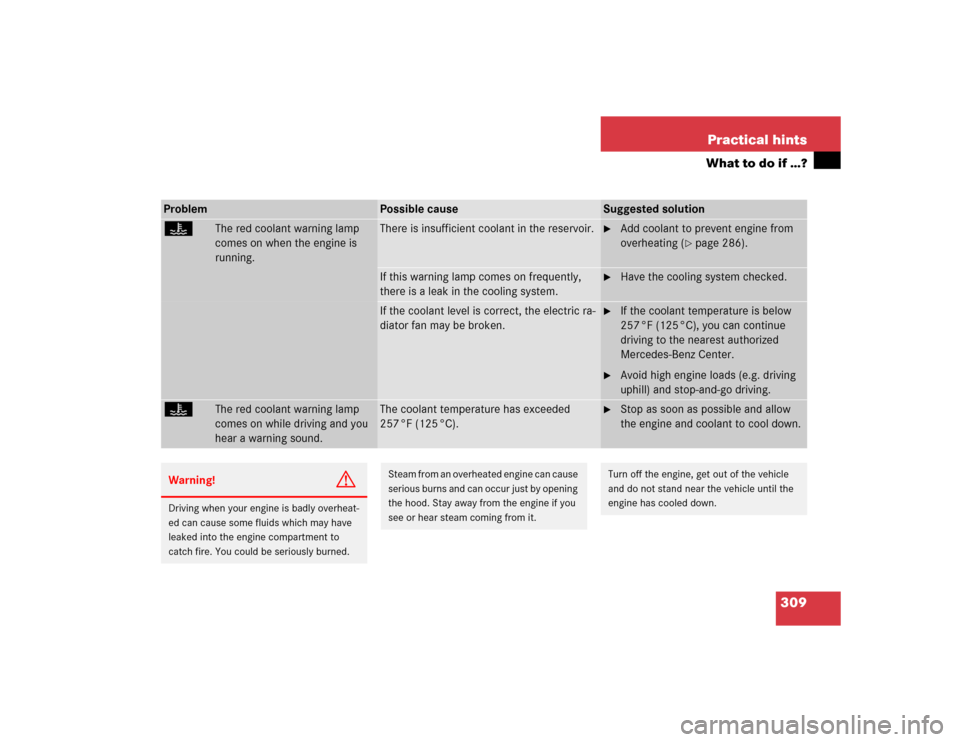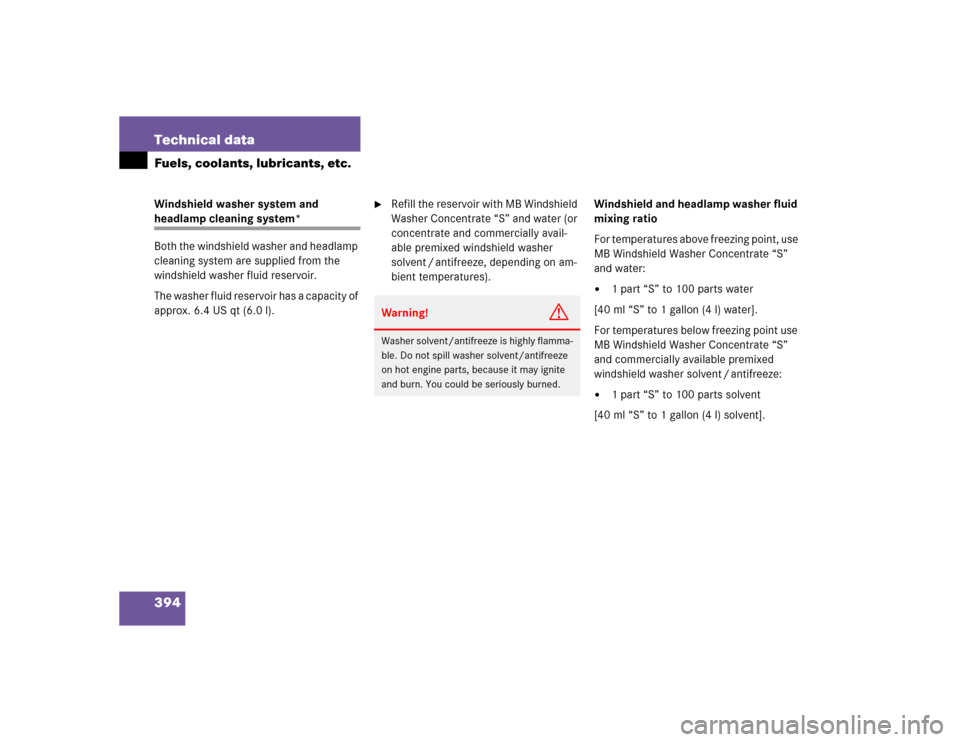Page 280 of 440

280 OperationAt the gas stationCheck regularly and before a long trip
1Coolant level
More information on coolant can be
found in the “Operation” section on
(
�page 286).
2Brake fluid (fuse box cover removed)
Removing fuse box cover (
�page 373)
3Windshield washer and headlamp
cleaning system
More information on refilling the reser-
voir can be found in the “Operation”
section on (
�page 289).Engine oil level
More information on engine oil
(
�page 283).
Opening hood (
�page 281).
Vehicle lighting
Check function and cleanliness.For more
information on replacing light bulbs, see
“Replacing bulbs” (�page 350).
Exterior lamp switch (�page 47)
Tire inflation pressure
More information on tire inflate pressure
(
�page 292).
!If you find that the brake fluid in the
brake fluid reservoir has fallen to the
minimum mark or below, have the
brake system checked for brake pad
thickness and leaks immediately. Noti-
fy an authorized Mercedes-Benz Center
immediately. Do not add brake fluid as
this will not solve the problem. For
more information, see also “Practical
hints” (
�page 307).
Page 287 of 440

287 Operation
Engine compartment
1Coolant expansion tank�
Using a rag, turn the cap slowly approx-
imately one half turn to the left to re-
lease any excess pressure.
�
Continue turning the cap to the left and
remove it.The coolant level is correct if the level
�
for cold coolant: reaches the black top
part of the reservoir
�
for warm coolant: is approx. 0.6 in
(1.5 cm) higher
�
Add coolant as required.
�
Replace and tighten cap.
More information on coolant can be found
in the “Technical data” section
(
�page 392).
Warning!
G
In order to avoid any possibly serious burns:�
Use extreme caution when opening the
hood if there are any signs of steam or
coolant leaking from the cooling system,
or if the coolant temperature gauge indi-
cates that the coolant is overheated.
�
Do not remove pressure cap on coolant
reservoir if engine temperature is above
194°F (90°C). Allow engine to cool
down before removing cap. The coolant
reservoir contains hot fluid and is under
pressure.
�
Using a rag, slowly open the cap approx-
imately
1⁄2 turn to relieve excess pres-
sure. If opened immediately, scalding
hot fluid and steam will be blown out un-
der pressure.
�
Do not spill antifreeze on hot engine
parts. Antifreeze contains ethylene gly-
col which may burn if it comes into con-
tact with hot engine parts.
Page 309 of 440

309 Practical hints
What to do if …?
Problem
Possible cause
Suggested solution
•
The red coolant warning lamp
comes on when the engine is
running.
There is insufficient coolant in the reservoir.
�
Add coolant to prevent engine from
overheating (
�page 286).
If this warning lamp comes on frequently,
there is a leak in the cooling system.
�
Have the cooling system checked.
If the coolant level is correct, the electric ra-
diator fan may be broken.
�
If the coolant temperature is below
257 °F (125 °C), you can continue
driving to the nearest authorized
Mercedes-Benz Center.
�
Avoid high engine loads (e.g. driving
uphill) and stop-and-go driving.
•
The red coolant warning lamp
comes on while driving and you
hear a warning sound.
The coolant temperature has exceeded
257 °F (125 °C).
�
Stop as soon as possible and allow
the engine and coolant to cool down.
Warning!
G
Driving when your engine is badly overheat-
ed can cause some fluids which may have
leaked into the engine compartment to
catch fire. You could be seriously burned.
Steam from an overheated engine can cause
serious burns and can occur just by opening
the hood. Stay away from the engine if you
see or hear steam coming from it.
Turn off the engine, get out of the vehicle
and do not stand near the vehicle until the
engine has cooled down.
Page 394 of 440

394 Technical dataFuels, coolants, lubricants, etc.Windshield washer system and headlamp cleaning system*
Both the windshield washer and headlamp
cleaning system are supplied from the
windshield washer fluid reservoir.
The washer fluid reservoir has a capacity of
approx. 6.4 US qt (6.0 l).
�
Refill the reservoir with MB Windshield
Washer Concentrate “S” and water (or
concentrate and commercially avail-
able premixed windshield washer
solvent / antifreeze, depending on am-
bient temperatures).Windshield and headlamp washer fluid
mixing ratio
For temperatures above freezing point, use
MB Windshield Washer Concentrate “S”
and water:
�
1 part “S” to 100 parts water
[40 ml “S” to 1 gallon (4 l) water].
For temperatures below freezing point use
MB Windshield Washer Concentrate “S”
and commercially available premixed
windshield washer solvent / antifreeze:
�
1 part “S” to 100 parts solvent
[40 ml “S” to 1 gallon (4 l) solvent].
Warning!
G
Washer solvent/antifreeze is highly flamma-
ble. Do not spill washer solvent/antifreeze
on hot engine parts, because it may ignite
and burn. You could be seriously burned.